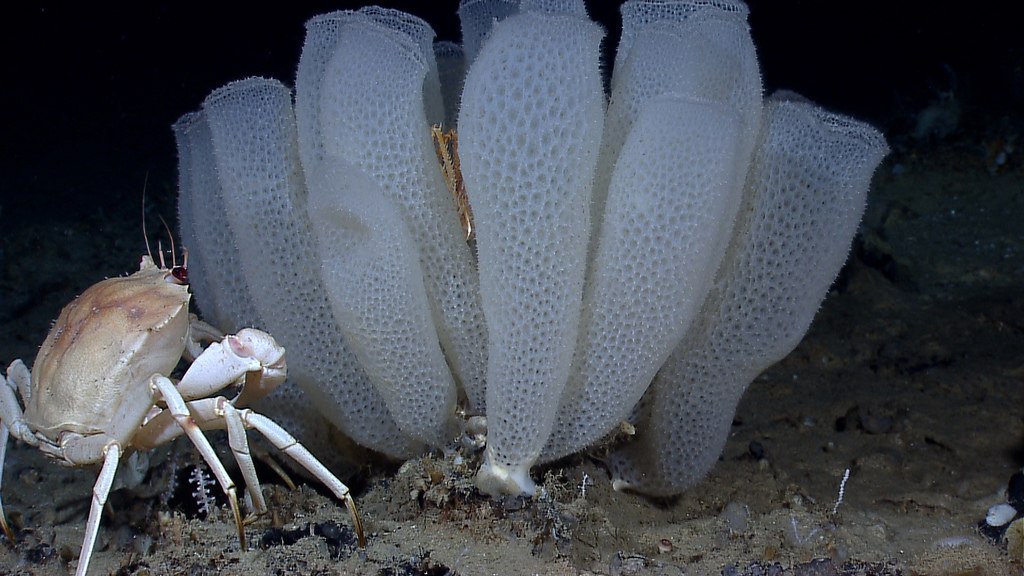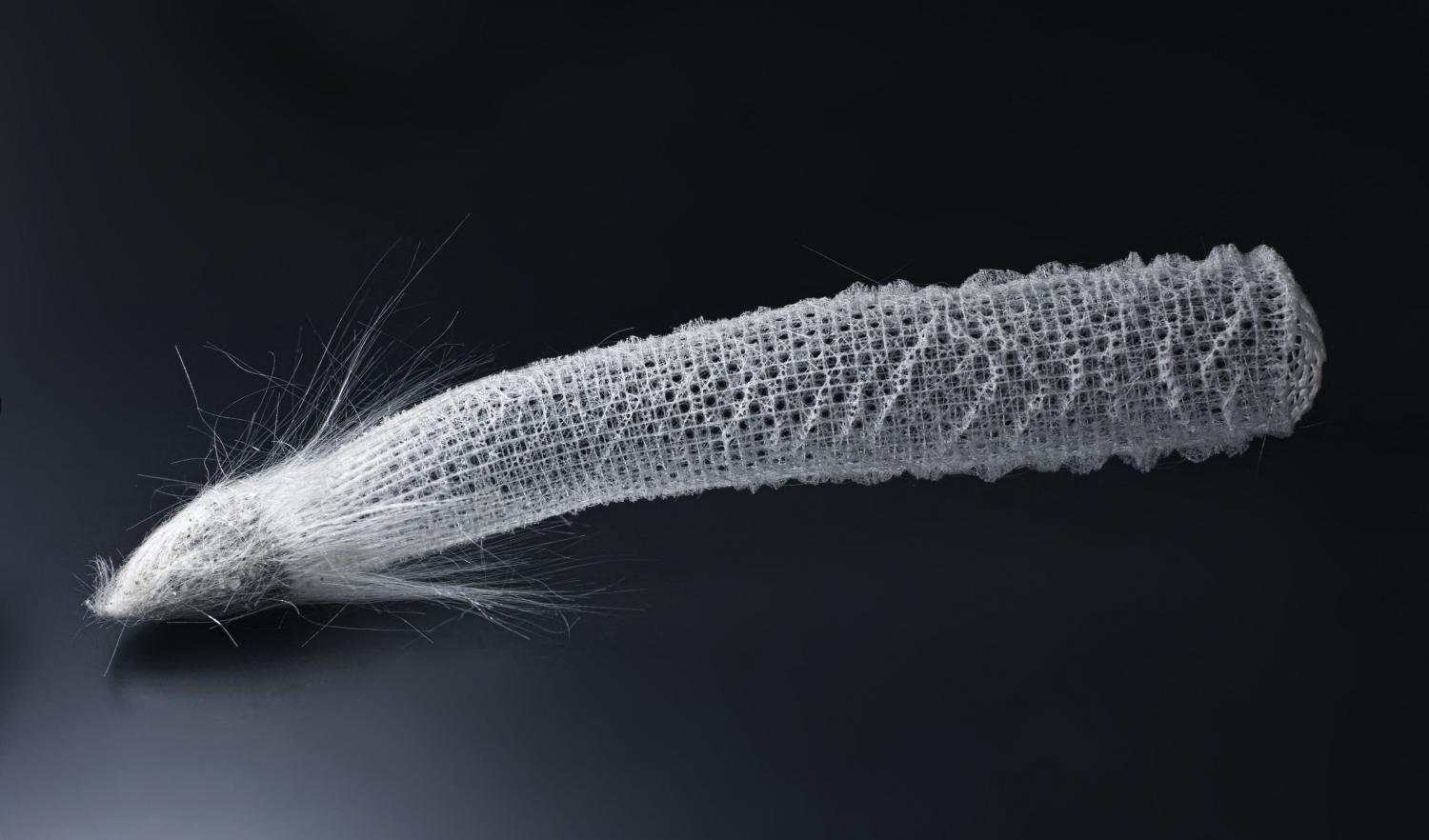Physics in the animal world: sea sponges and their "fiber"

The crab probably came to admire the perfect skeleton structure of glass sponges of the type. Venus basket.
Sea sponges are primitive organisms. These are invertebrate animals that spend almost their entire lives, attached to rocks or the bottom. Sponges are found almost everywhere, from coastal zones to the deepest places in the ocean. There are approximately 8,000 species of sponges . They do not have real tissues and organs, their functions are performed by individual cells and layers of cells. They feed on sponges, driving water through their own body. The filtrate, which receives small creatures and various organic particles, and serves as food for the sponge.
There are also predatory sponges - there are about 140 species of them. These predators feed on crustaceans and other small animals. For hunting, sponges of the Cladorhizidae family use long sticky threads of a cell structure. When the victim sticks to the thread, it shortens, tightens the victim to the sponge, which gradually envelops the victim and digests it. Sponge water filtration is used not only to get food, but also to get oxygen for body tissues. According to experts, every day many types of sponges pump a volume of water through themselves, exceeding their own body volume by 20,000. One of the most unusual types of sponges is Cladorhizidae. These creatures can be called a living optical fiber.
This sponge belongs to the class of glass sponges (six-sponges), which create their own basis of silicon dioxide. These living organisms are very beautiful, because the threads of the "skeleton" are intertwined in the most unusual combinations. Glass sponges such as Cladorhizidae usually live with shrimps, which occupy the inner cavity of the skeleton. Shrimps swim inside the larvae, and after the molt they remain to live inside, because they cannot pass through the cells of the glass network. The size of glass sponges reaches 20-30 centimeters.
Glass sponges previously interested experts from Bell Labs. Representatives of the company, examining the skeleton fibers, concluded that the material is similar in structure to fiber. The length of the sponge fibers is 5-15 cm, and the diameter is 40-70 microns. The structure of the fibers is complex, they are multi-layered objects. The center is a rod of, in fact, quartz glass. This core is surrounded by layers of organic matter and a shell. Moreover, the shell has a special structure that provides the ability to conduct light through artificial fibers.
 Specialists from Bell Labs were surprised that sponges create their fibers in water at low temperatures. Man also produces fiber using expensive equipment at high temperatures in special furnaces. According to the specialist Joanna Eisenberg, sponges can be an example of an alternative way of producing optical fiber. Moreover, the peculiarity of the material produced by sponges is its strength and flexibility. Such fibers are much less fragile and practically do not crack. They can easily be tied into a knot, the optical properties of the channel with virtually no damage. The light through these fibers is very good, because the sponge is used in the formation of its glass skeleton sodium ions, which improves the optical properties of the material. Naturally, Sodium is added by these organisms under the conditions of the same low temperature in the aquatic environment. For fiber manufacturers, the control of sodium ions in the production process is still a problem.
Specialists from Bell Labs were surprised that sponges create their fibers in water at low temperatures. Man also produces fiber using expensive equipment at high temperatures in special furnaces. According to the specialist Joanna Eisenberg, sponges can be an example of an alternative way of producing optical fiber. Moreover, the peculiarity of the material produced by sponges is its strength and flexibility. Such fibers are much less fragile and practically do not crack. They can easily be tied into a knot, the optical properties of the channel with virtually no damage. The light through these fibers is very good, because the sponge is used in the formation of its glass skeleton sodium ions, which improves the optical properties of the material. Naturally, Sodium is added by these organisms under the conditions of the same low temperature in the aquatic environment. For fiber manufacturers, the control of sodium ions in the production process is still a problem.Bell Labs studied the structure of sponge fiber, finding out that it consists of several layers. The optical properties of each layer are different. As mentioned above, the center of the sponge optical fiber is a rod of pure quartz glass. Concentric layers of glass surround the core as the sponge grows. It is this structure that makes the fiber formed by the sponge very resistant to fractures and cracks. Separate layers are glued together with a special organic glue. As the skeleton is formed, the individual fibers intertwine together, and form something resembling a lattice.

The structure of the skeleton of glass sponges has much in common with the structure of buildings and structures created by man. True, the “buildings” that the sponge creates are 1000 times smaller than most objects of this type created by man. The photo shows the Swiss Tower from London, Hotel De Las Artes from Barcelona and the structural element of the Eiffel Tower.
The lattice is enhanced.special substance (mesoglue), and the skeleton of the sponge under the influence of mesoglue and the sheath of fibers becomes quite durable. According to experts, this structure is similar to that used by architects who create buildings in seismically hazardous areas. Such material can be slightly deformed, but it is very difficult to break it. Evolving sponges have learned to build the most durable skeletons of the minimum amount of material. Researchers say that the sponge uses exactly as much material as is required, and no more.
Interestingly, a sponge species Euplectella aspergillum(already mentioned above "basket Venus") is attached to the bottom with elastic glass needles, spicules, whose diameter is 50 microns. Their length can reach 10 centimeters. These spicules are very strong, so tearing them off the sponge is very difficult.
Last year, scientists studying glass sponges, conducted a simulation of the mechanical properties of the artificial fibers of these creatures. The goal was to find the optimal sequence of cylinder thickness to achieve maximum tensile strength of the skeleton. As it turned out, the calculated parameters are very close to real. Sponges use a reduction in thickness from the center to the edge.

Joanna Eisenberg argues that the skeleton of glass sponges is one of the best solutions in engineering mechanics. Perhaps this material will be able to help a person discover new possibilities of materials science and improve engineering design. This structure is very complex, it concerns both individual fibers and the entire skeleton as a whole. “It baffles me. I can't imagine how sponges form their skeleton from individual fibers, creating almost perfect structures, ”said Eisenberg. Now scientists assume that in the center of each fiber, when it is formed, there is a protein that plays an important role in the creation of both the core and the entire optical fiber as a whole.
“It's amazing how many engineering construction methods use sponges to create a skeleton,” says James Weaver, a scientist at the University of California, Santa Barbara.
